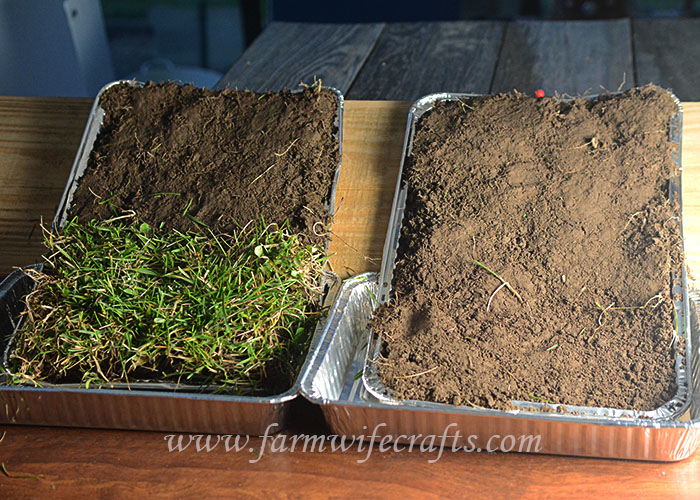
Fill a small bottle with water add a drop of blue food coloring shake and pour into the deep part of your pan. Learn more about the Earth and how weathering erosion and deposition happens.

In a sunny spot outside place six colored pieces of paper next to each other and place an ice cube in the middle of each paper.
Erosion experiments for kids. So here is a fun candy erosion experiment for those extra sweet treats. This experiment is based on the idea that moving water erodes rocks faster than water that is sitting still. The jar that we shake represents a fast moving river where the control jar.
The trays with coverings of grass grass and sticks wood chips pine needles and even rocks lost no soil to erosion during the nine-day test. Beach Formation Another experiment is to place sand in a slope at one side of a pan and then add enough water to cover about half of it. Lets find out in this erosion experiment.
In some parts of the world houses are still made from mud and sand which makes them easier to knock down than homes made of brick and stone. To understand how these materials can and should be used to make homes youll need. Explore Soil Erosion and How Plants Purify Our Water.
This experiment is geared towards ages 8 and up. This experiment will take roughly one hour to set up the project and make observations. Adult assistance is required to cut soda bottles collect soil mulch leaves and grass with roots attached.
Fill a small bottle with water add a drop of blue food coloring shake and pour into the deep part of your pan. Add 4 more cups of water. Use the empty bottle to press up and down in the water to make waves.
Pay attention to how the water affects the sand. The three main forces that cause erosion are water wind and ice. Water is the main cause of erosion on Earth.
Although water may not seem powerful at first it is one of the most powerful forces on the planet. Here are some of the ways that water causes erosion. Feb 25 2021 - Learn about weathering erosion rocks and land forms.
Hands on activities with experiments for third fourth and fifth graders. Learn more about the Earth and how weathering erosion and deposition happens. See more ideas about weathering and erosion science lessons teaching science.
The water in the first cut is really dirty the water from the second and third cups are much cleaner which shows that both mulch as well as the root structure of plants assist in preventing soil erosion. Let the kids do this every day for a week or two and they will soon see how the soil erodes away in the first container while the plants hold the soil in the last one. This solar energy science experiment will teach kids about solar energy and how different colors absorb different amounts of energy.
In a sunny spot outside place six colored pieces of paper next to each other and place an ice cube in the middle of each paper. Then observe how quickly each of the ice cubes melt. Erosion Lab - YouTube.
If playback doesnt begin shortly try restarting your device. Sticks leaves and twigs. Build mounds of dirt forming as many valleys creeks and spurs as you can.
Place the sticks upright in the soil where you want your trees to be. Pile leaves and twigs where you would expect them to be on your hillside. Weathering and Erosion Activities for Kids.
For this it is best to work in the kitchen. Boil some water on the stove. Meanwhile in their sheets they write down their hypothesis on how erosion differs from weathering and what they think will happen when we pour hot water over each.
Erosion moves pieces of the Earth. As pieces of the Earth are broken down by weathering they are carried away in a process called erosion. Water is a common way that pieces of the Earth are moved to a new location.
Wind also contributes to erosion by blowing the particles away. Glaciers can pick up pieces of the Earth and drag them to new locations. A two-page proposal might win 200 to 600 in science supplies for your students.
Thousands of teachers win these grants every year. A good lesson plan that demonstrates the effects that occur with each type of weathering and erosion. This lesson plan can easily be used for an.
In this activity learners will experiment with the idea of soil erosion which is the washing or blowing away of soil. Your scientist will also hypothesize about ways to help prevent soil erosion. Throughout the experiment you will ask questions that will inspire your child to think about soil erosion as well as to consider.
Weathering is caused by wind water heat and cold. Erosion happens via wind water and gravity. Weathering and erosion typically happen over hundreds thousands or even millions of years.
Boulders become sand and mountains are reduced to smaller hills. The pieces move downhill creating new landforms. Its a never-ending process.
Physical and Chemical Weathering Experiments. Team Weathering and Erosion are always working together when it comes to changing the Earths surface. Since recently I shared some hands-on erosion experiments I thought why not share the other partner in crime weathering.
Is it like the chicken and the egg who came.